ZATSUYOSEN!
 (NOJIMA MARU, prewar)
(NOJIMA MARU, prewar)
IJN NOJIMA MARU:
Tabular Record of Movement
© 2011-2017 Gilbert Casse, Bob Hackett and Peter Cundall
Revision 3
3 February 1934:
Nagasaki. Laid down by Mitsubishi Zosen K.K. Zosensho shipyard as a 7,189-ton cargo ship for Nippon Yusen Kaisha (NYK), Tokyo.
24 October 1934:
Launched and named NOJIMA MARU. [1]
13 February 1935:
Completed and registered at Tokyo.
E 1935:
NOJIMA MARU is placed on NYK’s New York Line. Outboard voyage, loaded with raw silk, sugar manganese, palm oil and general cargo, ships of this line call at the Philippines, Hong Kong, Kirun, Formosa (now Keelung, Taiwan), Shanghai and Taku (Tientsin) and return to Japan calling at Osaka, Kobe, Yokohama and other domestic ports. After crossing the Pacific to Los Angeles, they steam to New York via Balboa and Cristobal. Then they call at Boston, Baltimore, Philadelphia and Norfolk, Virginia. The return trip with a cargoes of steel products, cotton and general cargo follows roughly the same
route.
E 1940:
Her Gross Registered Tonnage is changed to 7,190-tons.
19 July 1941:
Requisitioned by the IJN as a transport (Ippan Choyosen). [2]
20 September 1941:
Registered in the IJN as an auxiliary transport under internal order No. 1093 and attached to the Kure Naval District as an auxiliary transport, (Ko) category. Homeport is Kure Naval Base. Navy Captain (later KIA) Itagaki Koichi (38) is appointed Supervisor. [3]
1 December 1941:
NOJIMA MARU is assigned as an auxiliary transport to the Combined Fleet, Southern Fleet, 9th Base Force, under Rear Admiral (later Vice Admiral) Hiraoka Kumeichi (39).
3 December 1941:
Departs Samah, Hainan Island, China for Pulo Condor (Poulo Condor) Island, Indochina (now Côn Son
Island, Vietnam).
5 December 1941:
Arrives at Pulo Condor.
6 December 1941: Operation “E” – The Invasion of Malaya:
Departs Pulo Condor for Singora, Siam (now Songkhla, Thailand) as part of the Singora Invasion Unit. This combined IJN/IJA operation is under operational control of the IJA. The IJN Singora Invasion Unit consists of minelayer HATSUTAKA (F) with the 9th Base Force Unit aboard, auxiliary seaplane tender KAMIKAWA MARU with six Mitsubishi Type 0 F1M2 (plus two in reserve) and three Aichi Type 0 E13A1 (plus one in reserve) floatplanes, auxiliary seaplane tenders SANYO and SAGARA MARUs each with six Mitsubishi Type 0 F1M2 and two Kawanishi Type 95 E8N2 (in reserve) floatplanes; destroyers AMAGIRI, ASAGIRI, YUGIRI and MURAKUMO; minesweepers W-1, W-4, W-5 and W-6; subchaser CH-8; auxiliary minesweeper tender EIKO MARU with 91st Naval Guard Unit aboard and auxiliary transport NOJIMA MARU with 91st Ports and Docks Unit and 91st Naval Signal Unit aboard.
The IJA Singora Invasion Unit is under command of LtGen Yamashita Tomoyuki’s 25th Army. Troops involved were elements of 5th Division (5th Hy Company, Kawamura Detachment Brigade, 5th Engineer Battalion (bn), 5th Rec bn) 1st Tank bn with 37 Med Type 97 and 20 Lt Type 95 tanks, 9th Railroad Eng
Battalion, 11th Eng bn and various Air units. Troops are carried by Army landing craft depot ship SHINSHU (RYUJO) MARU and Army transports AOBASAN, ASAKA, ATSUTASAN, KANSAI, KYUSHU, NAMINOUE, NAKO, SADO and SASAGO MARUs. One Ship AA Rgt and one Ship Signal Rgt are also carried on the transports. Further Invasion
Units are destined for Kota Bharu, Malaya.
7 December 1941:
At 2340, the Invasion Convoy arrives at Singora. Landings proceed without strong opposition.
19 December 1941:
NOJIMA MARU departs Singora for Koh Samui Island, Siam.
20 December 1941:
Arrives at Koh Samui.
21 December 1941:
Departs Koh Samui for Singora.
22 December 1941:
Arrives at Singora.
23 December 1941:
Departs Singora for Kuching, Malaya. The Japanese invasion force for Operation Q had landed there the previous day.
25 December 1941:
Arrives at Kuching.
26 December 1941:
Departs Kuching for Saint Jacques, Indochina.
29 December 1941:
Arrives at Saint Jacques. Departs later and arrives that same day at Saigon (now Ho Chi Minh City).
2 January 1942:
Departs Saigon and arrives at Saint Jacques.
3 January 1942:
NOJIMA MARU is now assigned to Combined Fleet, 1st Southern Expeditionary Fleet, 9th Base Force.
4 January 1942:
Departs Saint Jacques for Singora.
5 January 1942:
Arrives at Singora.
11 January 1942:
NOJIMA MARU is now assigned to the 15th Special Base Force for the forthcoming Anambas Islands operation.
12 January 1942:
Departs Singora for Pulo Condor.
13 January 1942:
Arrives at Pulo Condor.
24 January 1942:
Departs Pulo Condor for Anambas Islands, Dutch East Indies.
25 January 1942: Operation "R" - The invasion of the Anambas Islands:
NOJIMA MARU is attached to the 9th Base Force. The Anambas Islands are to be used as an advanced naval base and probably a seaplane base for the Malaya and Dutch East Indies campaigns. At the same time, landings at Endau in the southern Malayan peninsula are to take place. Rear Admiral (later Vice Admiral) Kurita Takeo's (38)(former CO of KONGO) invasion force consists of the Army transports KANSAI and CANBERRA MARUs escorted by light cruiser SENDAI, destroyers AMAGIRI, ASAGIRI, YUGIRI, FUBUKI, HATSUYUKI and SHIRAYUKI, subchasers CH-7, CH-8 and CH-9 and minesweepers W-1, W-2, W-3, W-4 and W-5. [4]
26 January 1942:
Arrives at Anambas Islands. The landings proceed without opposition.
19 February 1942:
Departs Anambas for Singapore.
22 February 1942:
Arrives at Singapore.
5 March 1942:
Departs Singapore for Penang, Malaya.
7 March 1942:
Arrives at Penang.
9 March 1942:
Departs Penang for Singapore.
11 March 1942:
Arrives at Singapore.
15 March 1942:
Departs Singapore for Penang.
17 March 1942:
Arrives at Penang.
19 March 1942: “U” Sakusen (Operation “U”) – The Initial transport operation to Burma:
Subchasers CH-7 and CH-8 depart Singapore in the No. 2 Escort Unit comprised of light cruiser KASHII (F), DesRon 3’s SHIKINAMI and DesRon 5’s ASAKAZE, HARUKAZE, HATAKAZE and MATSUKAZE, kaibokan SHIMUSHU, minelayer HATSUTAKA, MineSweepDiv 1's W-1, W-3 and W-4 and Rear Admiral (later Vice Admiral) Ishikawa Shigeru’s (40) 12th Special Base Force's torpedo boat KARI and auxiliary gunboat KOSHO MARU. The warships escort the First Burma Transport Convoy consisting of 31 IJA ships carrying the main body of the IJA 56th Division: AOBASAN, CELEBES, GENOA, GLASGOW, HARUNA, HAVRE, HIBURI, HOFUKU, HOKUMEI, KAZUURA, KIZAN, KOTOHIRA, KUSUYAMA, MOMOYAMA, MYOKO, NAGARA, NAKO, NAPLES, NICHIRAN, SAKITO, SANKO, SHINAI, SHINANOGAWA, SHINRYU, SHUNSEI, SUMATRA, SYDNEY, TATEISHI, TOKIWA, TSUYAMA and YAE MARUs.
20 March 1942:
Penang, Malaya. The 12th Special Base Force's transport IJN NOJIMA MARU joins the convoy.
23 March 1942:
At 1800, the convoy arrives at Rangoon, Burma (now Yangon, Myanamar).
7 April 1942:
Departs Rangoon for Port Blair, Andamans.
8 April 1942:
Arrives at Port Blair.
11 April 1942:
Departs Port Blair for Saigon.
16 April 1942:
Arrives at Saigon.
23 April 1942:
Departs Saigon for Singapore.
25 April 1942:
Arrives at Singapore.
28 April 1942:
Departs Singapore for Port Blair.
1 May 1942:
Arrives at Port Blair.
2 May 1942:
Departs Port Blair for Rangoon.
3 May 1942:
Arrives at Rangoon.
9 May 1942:
Departs Rangoon for Penang.
11 May 1942:
Arrives at Penang.
13 May 1942:
Departs Penang for Singapore.
15 May 1942:
Arrives at Singapore.
16 May 1942:
Departs Singapore for Dungun, Malaya.
17 May 1942:
Arrives at Dungun. Loads iron ore.
21 May 1942:
Departs Dungun for Osaka.
23 May 1942:
NOJIMA MARU is attached as an auxiliary transport to the Combined Fleet's Second Fleet for Japan's third phase war strategy under secret order No. 554 effective 5 June.
29 May 1942:
Arrives at Osaka.
1 June 1942:
Departs Osaka for Sasebo.
4 June 1942:
Arrives at Sasebo.
10 June 1942:
Departs Sasebo for Truk, Carolines.
18 June 1942:
Arrives at Truk.
4 July 1942:
At 0600 departs Truk directly for Lae, New Guinea escorted by minelayer TSUGARU and submatine chaser CH-31.
7 July 1942:
At 1730 arrives at Lae. Unloads supplies.
8 July 1942:
Departs Lae for Rabaul, New Britain escorted by CH-31.
9 July 1942:
Arrives at Rabaul.
17 July 1942:
Departs Rabaul for Kavieng, New Ireland.
18 July 1942:
Arrives at Kavieng. Departs later that day for Truk. About 15 nms NE of New Ireland, NOJIMA MARU evades a torpedo and shells an unidentified submarine without scoring any hit. [5]
20 July 1942:
Arrives at Truk.
23 July 1942:
Departs Truk for Yokosuka.
29 July 1942:
Arrives at Yokosuka.
2 August 1942:
At 1345 HOKUROKU and NOJIMA MARUs depart Yokosuka escorted by destroyers UMEKAZE and AMATSUKAZE.
3 August 1942:
At 1600 the destroyers are detached.
4 August 1942:
Arrives at Kure. Departs later that day for Moji.
5 August 1942:
Arrives at Moji.
6 August 1942:
Departs Moji for Maizuru alone without escort.
7 August 1942:
Arrives at Maizuru. Unloads 40-tons of depth charges and 500-tons of cement.
E 8-15 August 1942:
Construction Unit No. 184 embarks. Loads ammunition.
16 August 1942:
Departs Maizuru for Kataoka Wan (Bay) (now Zaliv Kozyrevskogo), Shumushiro-To (Island) (now Ostrov Shumshu), northern Kuriles.
20 August 1942:
Arrives at Kataoka Wan.
21 August 1942:
At 1315, departs Kataoka Wan for Kiska Island (renamed Narukami-Jima by the Japanese after its capture), Aleutians, apparently alone.
25 August 1942:
At 0845, arrives at Kiska harbor.
E August-September 1942:
Troops disembark. Begins to unload ammunition and supplies.
15 September 1942:
At noontime, according to schedule, albeit slowly, unloading is completed. NOJIMA MARU prepares to depart on the following evening.
16 September 1942:
At 0437, NOJIMA MARU sustains a large air attack from American aircraft. Near-misses on her central port side hole the ship and flood her engine room, rending it unusable. All power is lost. One minute later, she suffers a direct hit amidships by a dud bomb. At 0442, NOJIMA MARU is machine-gunned and Captain (Rear Admiral posthumously) Itagaki Koichi is KIA. Emergency repairs and pumping begin, and together with patching holes, prevent the ship from sinking. At 0454, however, another air attack occurs and a hit opens a larger hole.
1 October 1942:
Sustains another aerial bombing from American aircraft. Receives a direct hit on her starboard side.
E October 1942:
NOJIMA MARU is towed by auxiliary gunboat FUKUEI MARU No. 10 from Kiska harbor to Trout Lagoon’s anchoring shoal and run aground to prevent sinking.
13 October 1942:
Deemed damaged beyond repair, NOJIMA MARU is abandoned by her crew.
16 October 1942:
Bombed again by American aircraft, but the bombs are duds.
17 October 1942:
Another raid by B-24s is inconclusive due to poor weather conditions.
20 April 1943:
Another bombing sets NOJIMA MARU afire. Engulfed in flames, she is deemed a constructive total loss. The wreck remains exposed along the shoreline in situ until 1956.
 (NOJIMA MARU, wreck postwar)
(NOJIMA MARU, wreck postwar)
1 July 1943:
Removed from the Navy List under internal order No. 1321.
E 1956:
NOJIMA MARU's stern section is refloated by American tugboat
SALVAGE KING. Towed by SALVAGE KING and Canadian tugboat SUDBURY II to Japan to
be sold for scrap, but the section sinks en route due to a storm. Her bow
section remains in situ almost straddling a small creek in Trout Lagoon.
Authors Notes:
[1] Also known as NOZAMA MARU.
[2] See Zatsuyosen home
page for a full explanation.
[3] There were two categories of Zatsuyosen.
(Ko) category with an IJN Captain as supervisor aboard and (Otsu) category
without.
[4] It is unclear which units are detached to the Anambas Islands
with NOJIMA MARU.
5] There is no record of this attack listed in Allied
sources.
Thanks go to Gengoro S. Toda of Japan.
-Gilbert Casse, Bob Hackett and Peter Cundall
Back to
IJN Transports Page






